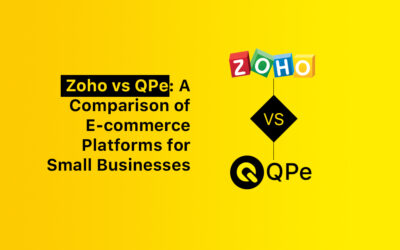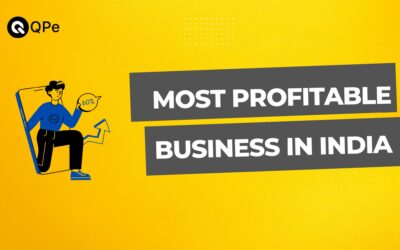When you think of taking your business online or opening your e-commerce store; meta ads recommend ‘Shopify’ as the best e-commerce tool. Yes, it is a great tool is not a good fit for every kind of business.
Shopify claims to offer a lower subscription fee, but its diverse pricing can be intimidating as this is only the initial cost. It does not include costs for using integrated tools, picking out impressive themes, or even transaction fees. Users are required to pay additional for these.
Selecting the right e-commerce platform initially is crucial to launching your business online hassle-free. QPe is a simple yet powerful e-commerce platform to sell your products worldwide.
You don’t have to pay any additional fees. From using its premium integrated tools to any type of transaction fee. QPe’s monthly subscription bears all types of additional costs.
So, let’s scroll to find out which e-commerce platform completes your business needs perfectly.
What is Shopify?
Shopify is an e-commerce platform that helps users launch their businesses online. It provides all the basic tools that are required to create an e-commerce website.
Shopify allows businesses to list products, manage inventory, receive payments globally, and provide logistics services. It has an infrastructure that a user can easily operate their e-store online without handling the technical part of anything.
Shopify has a gallery of interactive website themes designed to cater to different industries. Although all templates are not free, you can purchase them. Customize them with your brand logo, theme, and other details.
Shopify has many integrated tools that provide seamless services such as logistics, operations, or any type of transactional activity. Some of the basic tools are free, but there is a subscription fee to access them completely.
Additionally, in its higher subscription plan, you can easily integrate your e-store with multiple sales channels like Amazon, eBay, and social media marketplaces.
How Shopify Manages Merchant Costs?
Shopify has four diverse subscription plans: Basic, Shopify, Shopify Advanced, and Shopify Plus. Let’s break down each plan to understand which is affordable and give more access to the tools.
Basic
If you are a solo entrepreneur or small business owner, then this basic plan is perfect for you. This plan costs $29 monthly; a 2% transaction fee will be applied if paid through third-party merchants.
Advantages
- Access to a range of free themes and customization options to match your brand theme.
- Unlimited product listings and ten inventory locations.
- A discount code generator can create offers and promotional coupons.
Drawbacks
- 2% transaction fee if you don’t use Shopify payments.
- This allows up to two staff accounts only, which can be insufficient.
- This plan has limited features; you can’t access the professional reports and international pricing features.
Shopify plan
A Shopify plan that is designed for small teams. If you are planning to expand your business, this plan costs $79 monthly only and applies a 1% transaction fee if paid through third-party merchants. Cost $71.10 monthly if billed annually at $853.20.
Advantages
- Provides a balance of tools and resources.
- Allows up to 5 extra staff accounts.
- Access to professional reports and advanced marketing features.
Drawbacks
- This plan still costs more than the basic plan. 1% transaction fee still incurs.
- Costs are high but still lack some important features, such as third-party calculated shipping rates or advanced report building.
- Lack of checkout capacity and custom reporting system.
Shopify advanced
A Shopify advanced plan offers tailored features to complete most of the business requirements. It costs $299 monthly, $3,188 if billed annually. This plan applies a 0.6% transaction fee if paid through third-party merchants.
Advantages
- Up to 10x checkout capacity and real-time third-party shipping rate calculation.
- Allows up to 15 extra staff accounts.
- Give access to the advanced report builder tool and custom report-generating feature.
Drawbacks
- Such robust features can be unable to operate without hiring a dedicated technical person.
- A cost that can be afforded by large-scale businesses only.
- Small or midsized businesses couldn’t be able to utilize all the features.
Shopify plus
A Shopify Plus plan is designed for large-scale businesses that already have a large sales value and turnover. Businesses that require top-level features and scalability can purchase this monthly plan for $2,300. This plan also offers tailored pricing according to the requirements of large businesses.
Advantages
- Able to handle thousands of transactions and high traffic.
- Other sales channels, such as Amazon, eBay, Facebook or Instagram shopping, and Shopify POS.
- Users can automate their businesses with the Shopify Flow tool and streamline their business operations.
Drawbacks
- Shopify Plus costs $2,300; a large enterprise would also think twice before purchasing it.
- Unable to set up or manage without a dedicated technical expert.
- Extensive features will potentially lead to underutilization.
Shopify offers integration with powerful third-party tools for e-commerce business success, including both paid and free, but anyone can’t neglect its daunting subscription plans. It seems hard to afford these plans for small or midsize businesses.
This is where QPe stands out as a competitive alternative for all sizes of businesses. Our tailored and competitive pricing structure includes everything without any additional cost.
What Are The Hidden Costs Of Selling On Shopify?
We have learned about Shopify’s pricing structure, but transparency builds trust, and Shopify lacks it. Besides charging a higher amount for the storefront platform, Shopify also limits the use of its integrated tools and services.
These are the services that you need to pay additionally:
-
Subscriptions:
The initial subscription plans are diverse into four categories: Basic, Shopify, Shopify Advanced, and Shopify Plus. Users can also opt-in for a trial and starter pack.
-
Design & Templates:
Users can get up to 10 free parent website templates only. There are over 160 themes in Shopify, which range from $50 to $500.
-
Transaction Fees:
For every transaction other than the Shopify payments gateway, a fee of up to 2% applies to every transaction.
-
Payment Fees:
There is a fee for processing credit card payments also that varies from 2.9% + 30¢ to 3.9% + 30¢ USD.
-
Domain Fees:
You can buy a custom domain, which is usually around $15 per year for more brand-specific extensions.
-
App Fees:
Shopify paid tools subscription starts from a minimum of $5 and varies from service to service. Many prior tools, such as SEMrush, Loox product review apps, and Joy Rewards & Loyalty Program app subscriptions, cost up to $299.
-
Email Fees:
Shopify allows you to send 10,000 free emails; after that, it charges you $1 per thousand emails up to 300,000 emails. Last, it costs $0.55 per thousand emails if you cross 750,000 emails per month.
-
Marketplace Connect Fees:
1% of the fee charged after crossing the first 50 orders from marketplaces.
-
Integrated Shipping Fees:
You may get up to 77% discount on shipping rates.
-
Integrated Tax Solution Fees:
0.35% tax after $100,000 sales threshold.
-
Point of Sale Fees:
Fees for using Shopify POS are $89/month per location.
Add-ons
-
Marketing tools:
Shopify marketing tools costs start at $1 and differ according to the uses and tools.
-
Inventory Management:
Shopify’s built-in inventory management tool costs nothing, but it varies from $49 to $299 if users want to add third-party tools.
-
Analytics:
Shopify’s analytical tools range from $39 and go up to $399 per month.
Shopify offers a trial period of 3 days only, which includes all of its features, but you can’t start selling during the trial period. What the users can do is:
- Build the e-store
- Explore themes and designing tools.
- Practice the admin dashboard
- Add inventory and test the functionality of the selling process.
Some of the premium features and themes will still be unavailable during the trial period.
Why Choose QPe for Selling Your Products Online?
QPe, a leading and fastest-growing e-commerce platform, allows you to access all the required tools and parameters without any additional cost, making it easier to create a successful marketplace for your business.
From automation of your inventory and social media handles to SEO, Messenger Chatbots, Marketing, and Analytics. It doesn’t require you to hire any coding master or technical personnel. It is designed to boost your growth without taking on the stress of any type of burden. QPe provides a dedicated manager to resolve all queries.
A platform that doesn’t take cuts from your margins and lets you generate more revenue. Unlike Shopify, where transaction fees and other additional in-app purchases cut down the profits.
Choosing the perfect theme according to the brand’s aesthetics is crucial for the storefront and helps to decrease the website’s bounce rate. All our templates are free of charge and easily accessible on any device. It doesn’t require any coding to craft a unique and beautiful website with our eye-catching pre-designed website themes.
Comparison of Shopify Fees vs. Qpe’s No-Cut Policy
| Feature | Shopify | Qpe |
| Monthly Subscription | Starts at $29/month | Starts at $18/month |
| Transaction Fees | 0.5%-2% (if not using Shopify Payments) | No transaction fees |
| Add-On Costs | $10-$299/month for third-party apps | Most features included |
| Premium Themes | 11 free themes/$100-$500 for premium themes | All Free |
| Hidden Costs | Shipping tools, advanced apps, customizations | These features come with the subscription |
| Dedicated Manager | No | Yes |
| Technical Support | Yes, required | No, Managed by Dedicated Manager |
| AI Support | Included in higher plan | Yes, Included in all plans |
| Marketing Services | No | Yes |
Moreover, QPe allows you to sell on different marketplaces such as eBay, Etsy, Amazon, Flipkart, etc. They all can be managed easily from your dashboard in any plan. QPe helps you to leverage your website on these popular marketplaces and gives you real-life benefits and cost-effective approaches such as:
- Merchant keeps all the profits; QPe never asks for the cuts.
- Scale up your business without any unexpected expenses.
- Affordable pricing, which provides a budget-friendly e-store.
- Reliable and free integrated tools; no need to pay for third-party apps.
- Less set-up time, inventory automation, and a dedicated manager help you focus on your goals.
- QPe asks for no transaction fees at all.
- QPe asks for lower operational expenses only, which include everything. No hidden costs.
- QPe offers the flexibility to change the plan anytime from a small business to an enterprise
An online store developed on a fully automated e-commerce platform can help you get new customers every hour. An interactive user interface and buying guide with customer support assistance are all a business needs to grow rapidly.
How To Assess E-Commerce Platforms For Cost-Effectiveness
A cost-effective platform not only gives you an affordable storefront but also supports you on a long-term basis to scale your business without any hidden costs. Careful evaluation and planning are required in choosing the right one.
While evaluating or comparing merchant fees, hidden costs, platform features, or scalability, don’t trust only the ads; always try to consider these key factors:
Transaction fees:
Always look for a platform that has less or no transaction fees.
Third-party app costs:
Many platforms do not provide basic integrated tools, such as automation tools, marketing tools, or analytical tools. They required third-party app purchases, which cost $10 to $299 per month.
Premium themes or customizations:
Look for attractive theme availability or template options and avoid paying $100 to $500.
Multi-channel selling:
Make sure that the platform allows you to sell across multiple marketplaces.
Performance and growth:
QPe supports your scalability without any hidden cost. While Shopify only provides you with higher plans and additional expenses.
Transparent cost structure:
Always cross-check no-cut pricing policies.
Trial periods:
Avail free trial periods to test platform features and services.
Future expenses:
Make notes and calculate the total monthly costs.
Prefer a platform that provides you more for less, always. You can choose one: unpredictable expenses or higher profit. By evaluating these things, you can select the perfect e-commerce platform for your business.
Conclusion
Now, everyone knows that opening an online store is far cheaper than opening a shop. But, with QPe, you will save a lot of money by reducing tech costs and third-party integrations or software. Also ensures that you will save more time by automating all the processes.
QPe is placed in the top 30 most trusted e-commerce platforms that provide affordability and reliability with customer services. QPe has won 4 recognitions in multiple categories.
Starting a small-scale business or planning to carry your business online, we have all the tools and integrations that make your business hassle-free. Experience our services with our free trial, or you can have a quick demo by visiting our website.
Frequently Asked Questions:
-
Do You Have To Pay For Shopify Hosting?
No. Shopify includes web hosting in all of its plans and offers eCommerce hosting as part of its plans, and it comes with unlimited bandwidth, security, backups, and CDN network features.
-
Is There A Free Shopify Trial?
Shopify offers a trial period of 3 days only, which includes all of its features, but you can’t start selling during the trial period.



